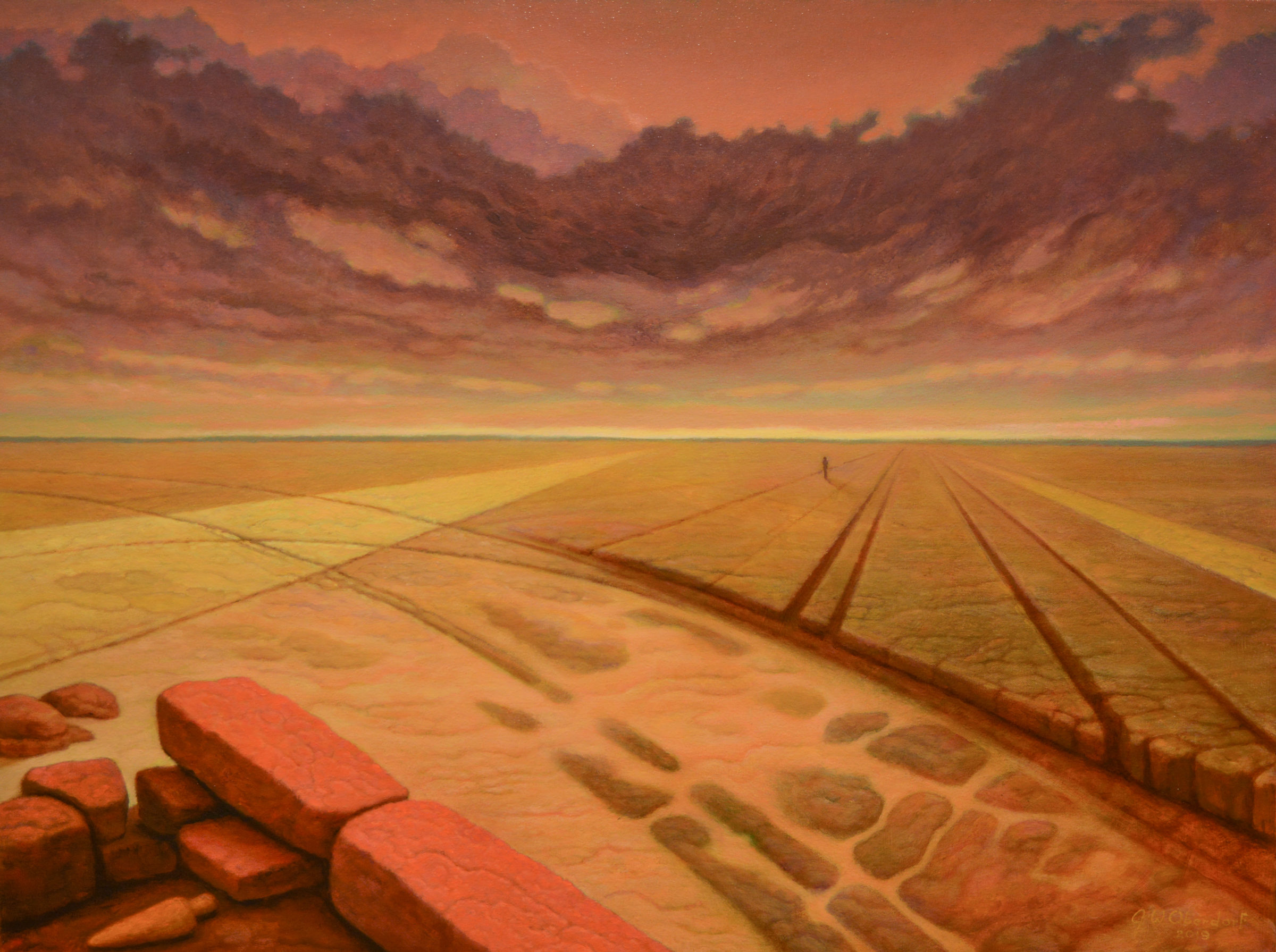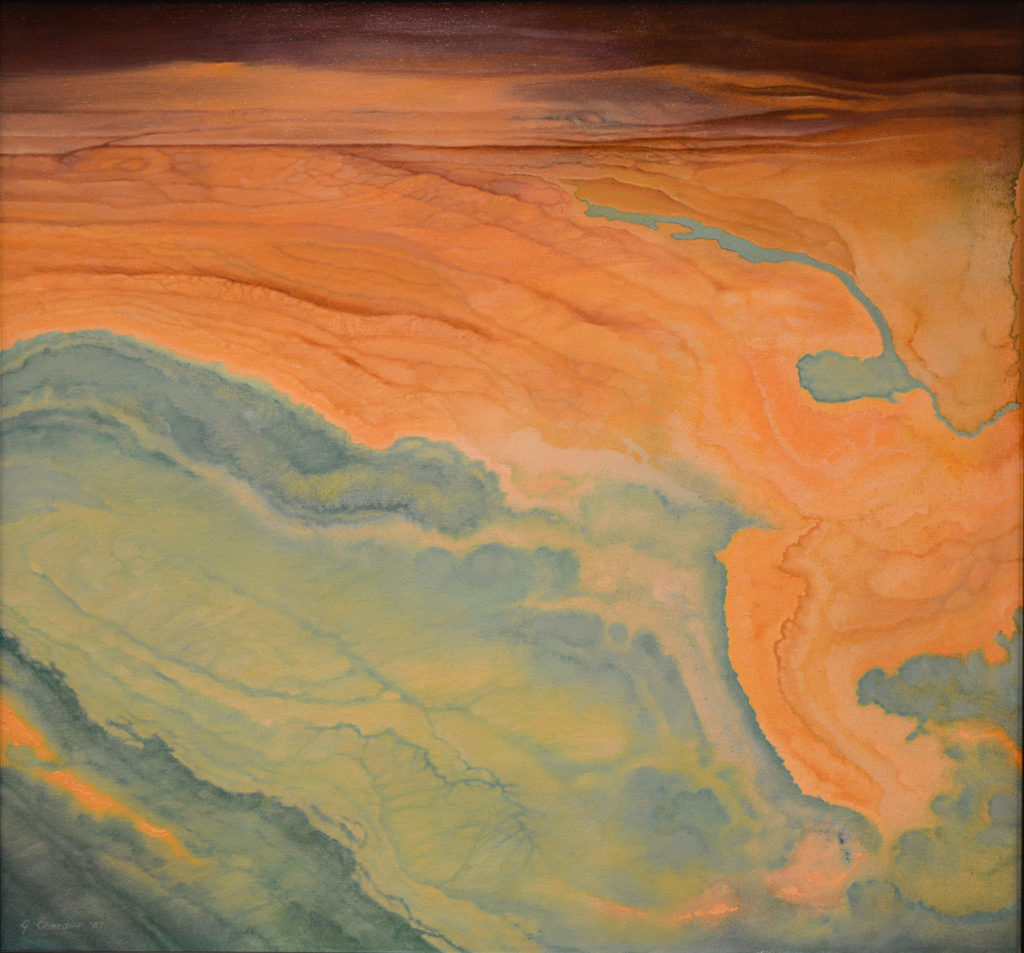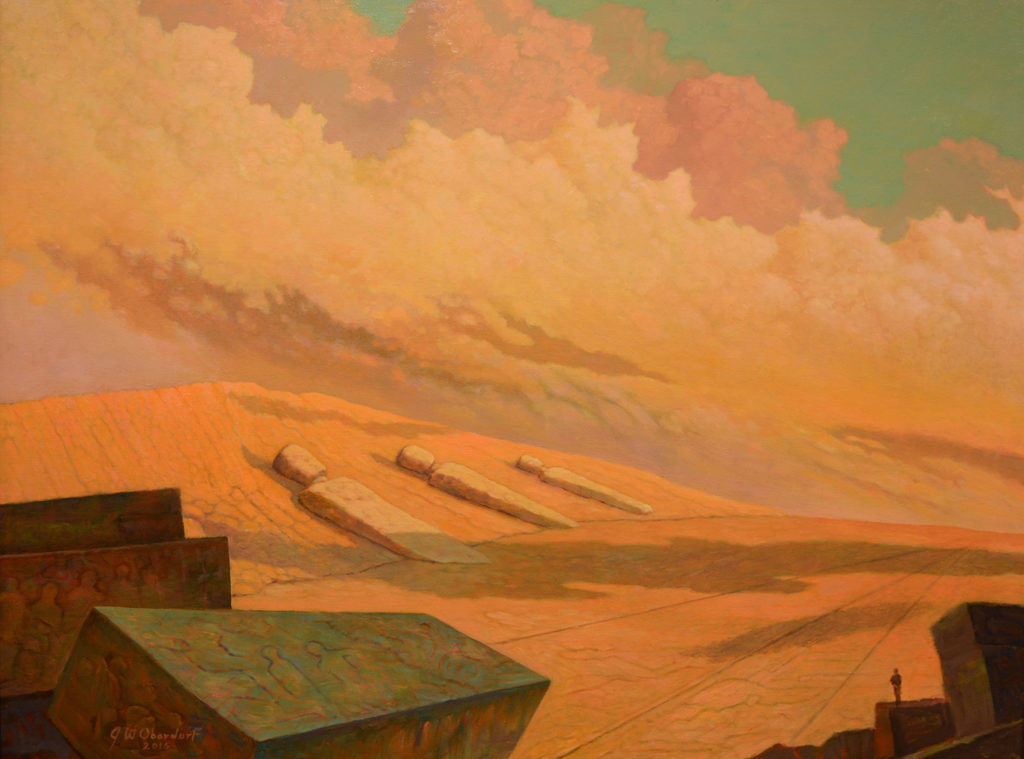
John Oberdorf: ArcheoSpaces
January 18 – February 23, 2020
Reception: Friday, January 17, 2020 | 5:30–7:30 PM
Bush Barn Art Center
John Oberdorf: ArcheoSpaces presents a survey of oil paintings that subtly play with our perception of reality and alludes to a dream-like existence. Oberdorf is a graduate of Oregon State University with a degree in Art with a minor in Anthropology. His work has exhibited in galleries throughout Arizona, California, and Oregon, is featured in numerous collections from New York to Los Angeles, and was reviewed in publications such as Art News.
[John Oberdorf, “Old Roads – Plain Geometry”]

“Interdimensional Continent” 
“Sleeping Giants No. 2”
Introduction to John Oberdorf’s Methods and Motifs
Ricardo De Mambro Santos • Willamette University
The exhibition ArcheoSpaces displays a series of paintings and drawings created in the last two decades by Salem-based artist John Oberdorf. Through the representation of vast, enigmatic landscapes and the depiction of minute, metamorphic geological formations, these images invite the audience to explore alternative dimensions of reality and access different planes of perception. Conceived as visual metaphors carefully composed in order to stimulate the viewer’s curiosity, imagination and memory, these works become potential fields of experiences for the beholder. Captured by the boundless magnitude of silent valleys, intrigued by the ambiguous shapes of indefinable figures or attracted by the stunning vividness of the details that populate these images, the viewer is motivated to contemplate at once, in an almost magical simultaneity, forms that appear immeasurably distant and elements that are represented incredibly close.
Such a well-balanced dilation of space guides, with gentle persuasion, the eyes of the beholder across the painting, inciting the audience to explore every element within these compositions. The farthest elements as well as the nearest objects, along with the presence of familiar and mysterious shapes, appear combined in ways that further contribute to expand the multiple temporalities of the visual journey, eliciting a state of mind in the viewer that is capable of directing one’s perception towards unknown horizons of knowledge, experience and thoughts.
The act of looking at a painting or a drawing created by John Oberdorf becomes a path of potential self-exploration. In his creations, fantasy and matter, mystery and revelation are the indissoluble points of convergence in which the eyes of the beholder can bring together and conciliate the unimaginable magnitude of fading landscapes with the minute materiality of rocks, totems and objects, orchestrating an itinerary of visual apprehension that is based on the juxtaposition of time and space, personal projections and collective myths. More than final destinations or self-contained narratives, the works elaborated by the artist offer themselves to the viewer as metaphorical gates, visual portals, wide open windows facing uncharted territories, disclosed toward inexhaustible semantic forests in the attempt to stimulate the audience to escape from any clichés or commonplaces and explore, on the contrary, new, possibly more personal dimensions of experience, beyond what has been already codified and disseminated through the forms of a collective system of knowledge, social practices or shared beliefs.
A graduate of Oregon State University with a degree in Art and a minor in Anthropology, John Oberdorf began his career creating illustrations – in a style that echoed closely but intelligently the visual vocabulary of a master of the caliber of Frank Frazetta – working for publishers such as Ace Books and other magazines specialized in sci-fi stories. His imagination, however, was not fulfilled by those enterprises, given the restrictive nature of this typology of visual narratives, in which images are inevitably subordinated to the coordinates prescribed by the genre or dictated by the particular story the artist was working on. Soon enough, John Oberdorf noticed that his capacity of elaborating “worlds of the possible” – to quote the artist’s words – reached a point of creative saturation and paralyzing predictability. Realizing, moreover, that “the landscape surrounding the people became more interesting to me than the figures they were supporting,” the painter’s career took a decisive turn from that moment on, moving toward the creation of autonomous iconographies represented within more articulated, evocative and remarkably vast pictorial spaces, further exploring certain atmospheres and tones associated with the poetics of Romanticism and, more specifically, with the concept of the Sublime.
Freed from the constrains of merely illustrative practices, the images elaborated by John Oberdorf revealed an increasingly personal working procedure, whose distinctive features were no longer attached to the limits of any particular genre or borrowed from previous sets of signs, symbols and codes, but nurtured by the artist’s own memories (especially from the period when he was living in Panama as a child) and reinvigorated by his passion for History, Archeology and Anthropology (mainly focused on narrative related to ancient, mythic or lost civilizations). Looking at the remotest past, the artist seemed more comfortable to construct – or acknowledge – his closest self. While his heart may have been in Atlantis, his mind was definitely projected into the future. A the same time, by following the premises of this suggestive dialogue with the past, in a most productive form of creative anachronism, John Oberdorf reinterprets the atmospheres explored by Romantic artists, adopting, with particular consistency, the evanescent luminosity of scenes that echo – and poetically update – the disquieting, yet intriguing, topographies created by the masters of the Sublime. The (outward) contemplation becomes the main path for an (inward) exploration.
Exhibition Sponsor
